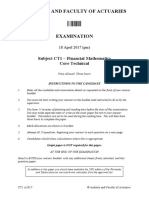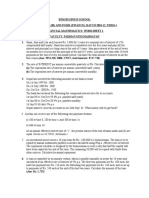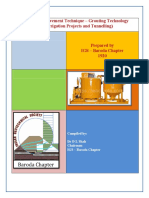CT1 QP 0506
CT1 QP 0506
Uploaded by
Subhash KumarCopyright:
Available Formats
CT1 QP 0506
CT1 QP 0506
Uploaded by
Subhash KumarOriginal Description:
Original Title
Copyright
Available Formats
Share this document
Did you find this document useful?
Is this content inappropriate?
Copyright:
Available Formats
CT1 QP 0506
CT1 QP 0506
Uploaded by
Subhash KumarCopyright:
Available Formats
Actuarial Society of India EXAMINATIONS
22nd May 2006 Subject CT1 Financial Mathematics
Time allowed: Three Hours (10.30 13.30 pm) INSTRUCTIONS TO THE CANDIDATES 1. 2. 3. Do not write your name anywhere on the answer scripts. You have only to write your Candidates Number on each answer script. Mark allocations are shown in brackets. Attempt all questions, beginning your answer to each question on a separate sheet. However, answers to objective type questions could be written on the same sheet. Fasten your answer sheets together in numerical order of questions. This, you may complete immediately after expiry of the examination time. In addition to this paper you should have available graph paper, Actuarial Tables and an electronic calculator.
4. 5.
Professional Co nduct:
It is brought to your notice that in accordance with provisions contained in the Professional Conduct Standards, If any candidate is found copying or involved in any other form of malpractice, during or in connection with the examination, Disciplinary action will be taken against the candidate which may include expulsion or suspension from the membership of ASI. Candidates are advised that a reasonable standard of handwriting legibility is expected by the examiners and that candidates may be penalized if undue effort is required by the examiners to interpret scripts.
AT THE END OF THE EXAMINATION Hand in both your answer scripts and this question paper to the supervisor.
ASI
CT1 0506
Q1) The force of interest (t) = 0.004t + 0.0002t2 for all t (i) Find present value of a sum of Rs.1000 payable at the end of 10 year from now. (ii) Find the constant annual effective rate of interest over ten year period
(3) (2) [5]
Q2) (i) Explain the relationship d = iv by general reasoning where d is the effective annual rate of discount and i is the effective annual rate of interest. (2) (ii) Calculate nominal rate of discount per annum convertible half yearly which is equivalent to (a) An effective rate of discount of 2.25% per quarter (b) A nominal rate of discount of 5% convertible every 2 years.
(2) (2)
(iii) A 91-day government bill provides the investor with an annual effective rate of return of 5%. Calculate the annual simple discount rate at which the bill is discounted. (2) [8] Q3) (i) Define No arbitrage. (ii) A one- year forward contract is issued on 1 January 2005 on a share with price of Rs.550 on that date. Dividends of Rs.60 are expected on 30 June 2005 and 31 December 2005. The risk-free spot rates for 6- month and 12- month are 5% and 5.5% per annum effective respectively on 1 January 2005. Calculate the forward price at issue, assuming no arbitrage. (4) [6]
(2)
Q4)
A housewife buys a refrigerator at Rs.15,000/- from a dealer under instalment scheme to be repaid in 36 equal monthly instalments payable in arrear. The amount of each monthly instalment is Rs.550/-. (i) Calculate the flat rate of interest p.a. (2) (ii) Calculate Annual Percentage Rate (APR ) (3) [5]
Q5) (i) Describe risk characteristics of fixed interest government bond.
(2)
(ii) 20-year fixed interest bond with coupon of 6% per annum payable half yearly was issued on 1 July 2005. The bond is redeemable at 120% at maturity date. An investor who pays both income tax and capital gains tax @ 30% purchased the bond on date of issue. The investors net yield to redemption was 8% per annum effective on the purchase. (a) Calculate the price paid by the investor. (4) Page 2 of 4
ASI
CT1 0506 (b) Calculate the duration of the net payments from the fixed interest bond for an investor, who does not pay any tax , at rate of interest 6% per annum convertible half yearly.
(4) [10] (3) (1) (1)
Q6) (a) List the factors that cause interest rates vary over time. (b) How do you measure 10- year spot rate, y10 ? (c) What is forward interest rate ft, r where t>0? (d) The 3-year and 7-year spot rates are 6.5% p.a. and 5.5% pa respectively. 3-year forward rate from time 4 is 5.7% p.a. Calculate (i) f3 (ii) y4
(4) [9]
Q7)
5 years ago, a borrower took a home loan of Rs.600,000 from a bank at rate of interest of 10% per annum effective. Loan is repayable by monthly installments of Rs. X each paid in arrears over 15-year period. (i) Calculate X. (3) (4)
(ii) Calculate the interest and capital components of 19th installment.
(iii) The rates of interest on home loan have fallen during past 5 years. In order to retain the customer, the bank makes an offer to the borrower to take a new loan equal to the outstanding loan at the end of year 5 at rate of interest of 8% per annum effective. The bank charges a processing fee equal to 4% of the original loan. The first loan is repaid and new loan is repayable over remaining 10 years period by monthly instalments in arrear. (a) Calculate the revised monthly instalment of the new loan. (4) (b) Calculate the present value of reduction in monthly instalment at the rate of interest of 8% per annum effective and show that the offer is profitable to borrower. (3) [14] Q8) (i) Briefly describe Call Option and Put Option. (2) (ii) Explain why selling a call option is not the same as buying put option? (2)
(iii) An investor purchases an ordinary share that pays annual dividend at price of Rs.600. The next dividend is due in exactly six months time and is expected to be Rs.30. It is expected that subsequent dividends will grow at the rate of 8% per annum effective and are expected to continue in perpetuity. The inflation is expected to be 5% per annum. Calculate the expected real rate of return per annum effective for the investor. (5) [9]
Page 3 of 4
ASI
CT1 0506
Q9)
A company ABC is considering investing in a project. The cost of project will be Rs.10 crore at the beginning of the first year. There are further costs at the beginning of second to fifteenth y ear. The cost at the beginning of second year will be Rs.1.5 crore and will increase every year thereafter at a rate of 5%. The income will be Rs.3.5 crore at the end of each of first 5 years, increasing by Rs.50 lakh at the end of each of sixth to fifteenth year.
The company ABC sets a discount rate of 15% pa to evaluate this project. (i) Explain what is meant by discounted payback period of a project (ii) Calculate net present value of the project (iii) Calculate the discounted pay back period for the project
(2) (7) (4) [13]
Q10) A Life Insurance Company sold a single premium bond with term of 10 years. The bond gives a maturity payment of 150% of single premium at the end of 10 years. Companys investment strategy for this bond is such that the expected annual effective rate of interest from investment is 8% and standard deviation of annual return is 11%. Annual returns are independent and (1+it ) follows lognormal distribution where it is the return in tth year. The company has received a premium of Rs.20,000. (i) Calculate the expected value and standard deviation of an investment of Rs. 20,000 at the end of 10th year, deriving all the formula used. (9) (ii) Calculate the probability that the accumulated value of the investment will be less than 60% of its expected value in 10 years time. (8) (iii) How much the company should invest at time t=0 such that accumulated value at time 10 exceeds maturity payout with 95% probability
(4) [21]
Page 4 of 4
You might also like
- CFA Level 1 Calculation Workbook: 300 Calculations to Prepare for the CFA Level 1 Exam (2024 Edition)From EverandCFA Level 1 Calculation Workbook: 300 Calculations to Prepare for the CFA Level 1 Exam (2024 Edition)Rating: 4.5 out of 5 stars4.5/5 (6)
- SIE Exam Practice Question Workbook: Seven Full-Length Practice Exams (2024 Edition)From EverandSIE Exam Practice Question Workbook: Seven Full-Length Practice Exams (2024 Edition)Rating: 5 out of 5 stars5/5 (1)
- Brochure Cleaning General Global enDocument36 pagesBrochure Cleaning General Global ensetnjaprirodom80No ratings yet
- CFP Certification Exam Practice Question Workbook: 1,000 Comprehensive Practice Questions (2019 Edition)From EverandCFP Certification Exam Practice Question Workbook: 1,000 Comprehensive Practice Questions (2019 Edition)Rating: 5 out of 5 stars5/5 (1)
- Act 1 - No Fear Shakespeare - Romeo and Juliet-1Document13 pagesAct 1 - No Fear Shakespeare - Romeo and Juliet-1Bunyanuch ThawornthaweewongNo ratings yet
- IandF CT1 201709 ExamDocument6 pagesIandF CT1 201709 ExamViorel AdirvaNo ratings yet
- Institute of Actuaries of India: ExaminationsDocument6 pagesInstitute of Actuaries of India: ExaminationsmailrahulrajNo ratings yet
- Actuarial Society of India Examinations: Subject 102 - Financial MathematicsDocument5 pagesActuarial Society of India Examinations: Subject 102 - Financial MathematicsbrcsNo ratings yet
- Institute of Actuaries of India: ExaminationsDocument5 pagesInstitute of Actuaries of India: ExaminationsHemanshu JainNo ratings yet
- Actuarial Society of India: ExaminationsDocument5 pagesActuarial Society of India: ExaminationsBhawnaSharmaNo ratings yet
- Actuarial CT1 Financial Mathematics Sample Paper 2011 by ActuarialAnswersDocument8 pagesActuarial CT1 Financial Mathematics Sample Paper 2011 by ActuarialAnswersActuarialAnswersNo ratings yet
- Actuarial Society of India: ExaminationsDocument5 pagesActuarial Society of India: ExaminationsdasNo ratings yet
- Institute of Actuaries of India: ExaminationsDocument4 pagesInstitute of Actuaries of India: ExaminationsRochak JainNo ratings yet
- CT1 QP 1114Document5 pagesCT1 QP 1114Anonymous Eibg11N9xNNo ratings yet
- Institute and Faculty of Actuaries: Subject CT1 - Financial Mathematics Core TechnicalDocument6 pagesInstitute and Faculty of Actuaries: Subject CT1 - Financial Mathematics Core TechnicalfeererereNo ratings yet
- Institute of Actuaries of India: ExaminationsDocument6 pagesInstitute of Actuaries of India: ExaminationsRochak JainNo ratings yet
- Institute and Faculty of Actuaries: Subject CT1 - Financial Mathematics Core TechnicalDocument40 pagesInstitute and Faculty of Actuaries: Subject CT1 - Financial Mathematics Core TechnicalVladmirNo ratings yet
- FandI Subj102 200009 Exampaper PDFDocument4 pagesFandI Subj102 200009 Exampaper PDFClerry SamuelNo ratings yet
- Institute and Faculty of Actuaries: Subject CT1 - Financial Mathematics Core TechnicalDocument19 pagesInstitute and Faculty of Actuaries: Subject CT1 - Financial Mathematics Core Technicalankitag612No ratings yet
- Examinations: Subject 102 - Financial MathematicsDocument5 pagesExaminations: Subject 102 - Financial MathematicsClerry SamuelNo ratings yet
- Assessment Paper and Instructions To CandidatesDocument3 pagesAssessment Paper and Instructions To CandidatesJohn DoeNo ratings yet
- ct12005 2012Document282 pagesct12005 2012Patrick MugoNo ratings yet
- Institute and Faculty of Actuaries: Subject CT1 - Financial Mathematics Core TechnicalDocument7 pagesInstitute and Faculty of Actuaries: Subject CT1 - Financial Mathematics Core TechnicalfeererereNo ratings yet
- Institute and Faculty of Actuaries: Subject CT1 - Financial Mathematics Core TechnicalDocument5 pagesInstitute and Faculty of Actuaries: Subject CT1 - Financial Mathematics Core TechnicalfeererereNo ratings yet
- Ilovepdf Merged 3Document77 pagesIlovepdf Merged 3Dani ShaNo ratings yet
- Financial Management 532635578Document30 pagesFinancial Management 532635578viaan1990No ratings yet
- Exam FileDocument14 pagesExam FileAbelNo ratings yet
- AoF Tutorial02 SpotDocument3 pagesAoF Tutorial02 SpotSeebsNo ratings yet
- Problems-Financial ManagementDocument13 pagesProblems-Financial ManagementGajendra Singh Raghav50% (2)
- CS Final - Financial Tresurs and Forex Management - June 2004Document4 pagesCS Final - Financial Tresurs and Forex Management - June 2004Rushikesh DeshmukhNo ratings yet
- RTP CA Final Old Course Paper 2 Management Accounting and FinDocument38 pagesRTP CA Final Old Course Paper 2 Management Accounting and FinSajid AliNo ratings yet
- Subjectct12005 2009Document176 pagesSubjectct12005 2009paul.tsho7504No ratings yet
- ct12010 2013Document144 pagesct12010 2013nigerianhacksNo ratings yet
- BUS288 Test Practice QuestionsDocument9 pagesBUS288 Test Practice QuestionsJayden Vincent0% (1)
- Section A: Question 1 - Compulsory (40 Marks) IDocument4 pagesSection A: Question 1 - Compulsory (40 Marks) IJay Napstar NkomoNo ratings yet
- Session 1 Handout ExDocument2 pagesSession 1 Handout ExasimmishraNo ratings yet
- Actuarial CT5 General Insurance, Life and Health Contingencies Sample Paper 2011Document11 pagesActuarial CT5 General Insurance, Life and Health Contingencies Sample Paper 2011ActuarialAnswers50% (2)
- Corporate Finance Academic Year 2011-2012 TutorialsDocument21 pagesCorporate Finance Academic Year 2011-2012 TutorialsSander Levert100% (1)
- Topic 3 ExamplesDocument9 pagesTopic 3 ExamplesJessica MccormickNo ratings yet
- Financial ManagementDocument3 pagesFinancial Managementshinuanusha50No ratings yet
- CT1 Exam PaperDocument8 pagesCT1 Exam PaperJames TriviaNo ratings yet
- Institute of Actuaries of India: Examinations 27 May 2009 Subject CA1 - Core Application Concept (Paper I)Document5 pagesInstitute of Actuaries of India: Examinations 27 May 2009 Subject CA1 - Core Application Concept (Paper I)YogeshAgrawalNo ratings yet
- Institute of Actuaries of India: ExaminationsDocument5 pagesInstitute of Actuaries of India: ExaminationsdasNo ratings yet
- Paper - 2: Strategic Financial Management Questions and Answers Questions International Capital BudgetingDocument33 pagesPaper - 2: Strategic Financial Management Questions and Answers Questions International Capital BudgetingAyushNo ratings yet
- 102 QP 0504Document5 pages102 QP 0504api-3701114No ratings yet
- Problem On Maturity GapDocument4 pagesProblem On Maturity GapRoohani WadhwaNo ratings yet
- MainExam 2018 PDFDocument12 pagesMainExam 2018 PDFAnonymous hGNXxMNo ratings yet
- CF&RM QPDocument7 pagesCF&RM QPBijay AgrawalNo ratings yet
- CIN2122 Tutorial 5Document2 pagesCIN2122 Tutorial 5tcze69No ratings yet
- Financial Management - Practice WorkbookDocument39 pagesFinancial Management - Practice WorkbookFAIQ KHALIDNo ratings yet
- Sem IV (Internal 2010)Document15 pagesSem IV (Internal 2010)anandpatel2991No ratings yet
- Finance RTP Cap-II June 2016Document37 pagesFinance RTP Cap-II June 2016Artha sarokarNo ratings yet
- Examination: Subject CT1 - Financial Mathematics Core TechnicalDocument5 pagesExamination: Subject CT1 - Financial Mathematics Core TechnicalfeererereNo ratings yet
- FIN - 301 - Tutorial Questions Set 1 - 2023Document3 pagesFIN - 301 - Tutorial Questions Set 1 - 2023b4zwkq5rmvNo ratings yet
- HW 2Document3 pagesHW 2Love MittalNo ratings yet
- 10-12 Assignment 1Document4 pages10-12 Assignment 1Pavan Kasireddy100% (1)
- Corporate Valuation NumericalsDocument47 pagesCorporate Valuation Numericalspasler9929No ratings yet
- Personal Money Management Made Simple with MS Excel: How to save, invest and borrow wiselyFrom EverandPersonal Money Management Made Simple with MS Excel: How to save, invest and borrow wiselyNo ratings yet
- FPQP Practice Question Workbook: 1,000 Comprehensive Practice Questions (2024 Edition)From EverandFPQP Practice Question Workbook: 1,000 Comprehensive Practice Questions (2024 Edition)No ratings yet
- The Exciting World of Indian Mutual FundsFrom EverandThe Exciting World of Indian Mutual FundsRating: 5 out of 5 stars5/5 (1)
- Securitization in India: Managing Capital Constraints and Creating Liquidity to Fund Infrastructure AssetsFrom EverandSecuritization in India: Managing Capital Constraints and Creating Liquidity to Fund Infrastructure AssetsNo ratings yet
- Applied Corporate Finance. What is a Company worth?From EverandApplied Corporate Finance. What is a Company worth?Rating: 3 out of 5 stars3/5 (2)
- Appendix I - Specification For Doors & WindowsDocument13 pagesAppendix I - Specification For Doors & WindowsSantoshkumar GurmeNo ratings yet
- Byd Dolphin Owner's ManualDocument204 pagesByd Dolphin Owner's ManualContent WallsNo ratings yet
- DELTABLOC Corporate Brochure EDocument22 pagesDELTABLOC Corporate Brochure EWendel RochaNo ratings yet
- Bird Diverter PresentationDocument12 pagesBird Diverter PresentationFede TapiaNo ratings yet
- Following The Updated List of Tiger Reserves in IndiaDocument3 pagesFollowing The Updated List of Tiger Reserves in Indiaashim kumar royNo ratings yet
- 67 - Interface Switching Monitoring PDFDocument86 pages67 - Interface Switching Monitoring PDFbata88No ratings yet
- Naskah Drama Lutung KasarungDocument7 pagesNaskah Drama Lutung KasarungAkbar AbbasyNo ratings yet
- Elegy For My Father's FatherDocument10 pagesElegy For My Father's FatherAshish JosephNo ratings yet
- Ground Improvement Technique - Grouting Technology (For Irrigation Projects and Tunnelling)Document109 pagesGround Improvement Technique - Grouting Technology (For Irrigation Projects and Tunnelling)Sumanth GundetiNo ratings yet
- Ieee Recommended Practice For Determining The Electric Power Station Ground Potential Rise and InducDocument131 pagesIeee Recommended Practice For Determining The Electric Power Station Ground Potential Rise and InducjaferreroNo ratings yet
- PEP 2020-2040 Signed 01102022Document307 pagesPEP 2020-2040 Signed 01102022JordanNo ratings yet
- Turn BUckle, Clevis With PIN Hex Nut. Andritz PDFDocument9 pagesTurn BUckle, Clevis With PIN Hex Nut. Andritz PDFHaery BrebesNo ratings yet
- Hardware Implementation of Real-Time Multiple Frame Super-ResolutionDocument6 pagesHardware Implementation of Real-Time Multiple Frame Super-Resolutionmouhamed al amin BenattiaNo ratings yet
- Dungeon Twister - Creatures Sylvestres - Quick - RulesDocument6 pagesDungeon Twister - Creatures Sylvestres - Quick - RulesTony LeMesmerNo ratings yet
- 8E Kelas 8 Bab 7 Inggris Semester 2 K13 Revisi 2017Document16 pages8E Kelas 8 Bab 7 Inggris Semester 2 K13 Revisi 2017sainalNo ratings yet
- Gujarat Technological UniversityDocument2 pagesGujarat Technological Universityfeyayel988No ratings yet
- Scaling of 100 KW Class Applied-Field MPD Thrusters Myers PDFDocument32 pagesScaling of 100 KW Class Applied-Field MPD Thrusters Myers PDFLuca MalacciNo ratings yet
- 310EDocument5 pages310EGLCNo ratings yet
- Eucharistic Prayer IIIDocument6 pagesEucharistic Prayer IIIJERONIMO PAPA0% (1)
- Frank Sinatra Lyrics - Cheek To Cheek PDFDocument1 pageFrank Sinatra Lyrics - Cheek To Cheek PDFalfonsoNo ratings yet
- Inventory Form For PpeDocument2 pagesInventory Form For PpeGary G. Corrales100% (1)
- Gabion Box CalaculationDocument10 pagesGabion Box CalaculationAbdullahiNo ratings yet
- SP4T SP5TDocument178 pagesSP4T SP5TPriyanka DwivediNo ratings yet
- Chapter 5 Asian Ethical TraditionsDocument16 pagesChapter 5 Asian Ethical TraditionsClara Leal Senabre Tripole100% (2)
- 1 OnlineDocument7 pages1 OnlineSmart Children AnimationNo ratings yet
- Philsat - Uap IlawDocument25 pagesPhilsat - Uap IlawKym AlgarmeNo ratings yet
- Answers:: 2 Out of 2 PointsDocument14 pagesAnswers:: 2 Out of 2 PointsCy RocamoraNo ratings yet
- Trajectory Tracking of A 2-DOF Helicopter System Using Fuzzy Controller ApproachDocument6 pagesTrajectory Tracking of A 2-DOF Helicopter System Using Fuzzy Controller Approachhai zhangNo ratings yet

























































































